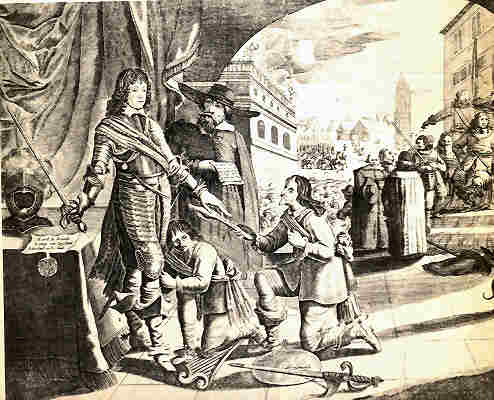



![]() The political scene in Scotland continued to deteriorate and fragment, and the English army continued to tighten its grip on the wealthy and influential regions of south and central Scotland. Despite its original ideology, the Kirk came to realize that, with the annihilation of the Western Association Army, it would have to allow men it had previously barred from serving in the army to rejoin. In other words, the Kirk was realizing that it would have to welcome Charles Stuart and his Royalist supporters back into the government if it hoped to repel the English from its lands.
The political scene in Scotland continued to deteriorate and fragment, and the English army continued to tighten its grip on the wealthy and influential regions of south and central Scotland. Despite its original ideology, the Kirk came to realize that, with the annihilation of the Western Association Army, it would have to allow men it had previously barred from serving in the army to rejoin. In other words, the Kirk was realizing that it would have to welcome Charles Stuart and his Royalist supporters back into the government if it hoped to repel the English from its lands.
![]() On the first day of the new year 1651, Charles Stuart II was crowned king at Scone. The crown was placed on his head by Argyll. Then, following his coronation as King Charles II, his majesty traveled to Aberdeen where he set up his standard and recruited troops. He then moved on to Stirling. He named Duke Hamilton as his Lieutenant-General, David Leslie as his Major-General, Middleton as the Major-General of the cavalry and Massey as the general of the Royalist English troops serving with the Scottish army.
On the first day of the new year 1651, Charles Stuart II was crowned king at Scone. The crown was placed on his head by Argyll. Then, following his coronation as King Charles II, his majesty traveled to Aberdeen where he set up his standard and recruited troops. He then moved on to Stirling. He named Duke Hamilton as his Lieutenant-General, David Leslie as his Major-General, Middleton as the Major-General of the cavalry and Massey as the general of the Royalist English troops serving with the Scottish army.

Charles Stuart II Is Courted By The Scots ~ Source unknown.
![]() The King started his reign by visiting all the garrisons located throughout Fife. To them he reassigned as many troops from Stirling as could be safely spared. He then traveled through the Highlands and attempted to quell some of the inter-clan disagreements so that the Highlanders would work together in his support. His efforts were largely successful; the town of Dundee alone raised a regiment of horse, equipped with six cannon. The King’s army rose to approximately twenty thousand men.
The King started his reign by visiting all the garrisons located throughout Fife. To them he reassigned as many troops from Stirling as could be safely spared. He then traveled through the Highlands and attempted to quell some of the inter-clan disagreements so that the Highlanders would work together in his support. His efforts were largely successful; the town of Dundee alone raised a regiment of horse, equipped with six cannon. The King’s army rose to approximately twenty thousand men.
![]() Charles’ crowning gave Royalists in England cause to hope that a restoration of the Stuart monarchy would replace the current state of affairs in the English government. A plot aimed at that object was discovered but quickly subdued. The prominent Presbyterian ministers, Love, Jenkins, Case and Drake, along with another man by the name of Gibbons, were apprehended and examined. Jenkins, Case and Drake all confessed to their guilt in the plot, and were pardoned. Love and Gibbons, on the other hand, were the primary forces behind the plot, and were duly condemned to be beheaded. That sentence would be carried out on 22 August on Tower-Hill in London. It should be noted that petitions for Love’s pardon had been submitted to Cromwell, who agreed to the pardon. But the Lord General’s letter of pardon, being carried from Edinburgh to London by a post rider, was intercepted by a group of cavaliers, who tore it up and sealed the Reverend Love’s fate.
Charles’ crowning gave Royalists in England cause to hope that a restoration of the Stuart monarchy would replace the current state of affairs in the English government. A plot aimed at that object was discovered but quickly subdued. The prominent Presbyterian ministers, Love, Jenkins, Case and Drake, along with another man by the name of Gibbons, were apprehended and examined. Jenkins, Case and Drake all confessed to their guilt in the plot, and were pardoned. Love and Gibbons, on the other hand, were the primary forces behind the plot, and were duly condemned to be beheaded. That sentence would be carried out on 22 August on Tower-Hill in London. It should be noted that petitions for Love’s pardon had been submitted to Cromwell, who agreed to the pardon. But the Lord General’s letter of pardon, being carried from Edinburgh to London by a post rider, was intercepted by a group of cavaliers, who tore it up and sealed the Reverend Love’s fate.
